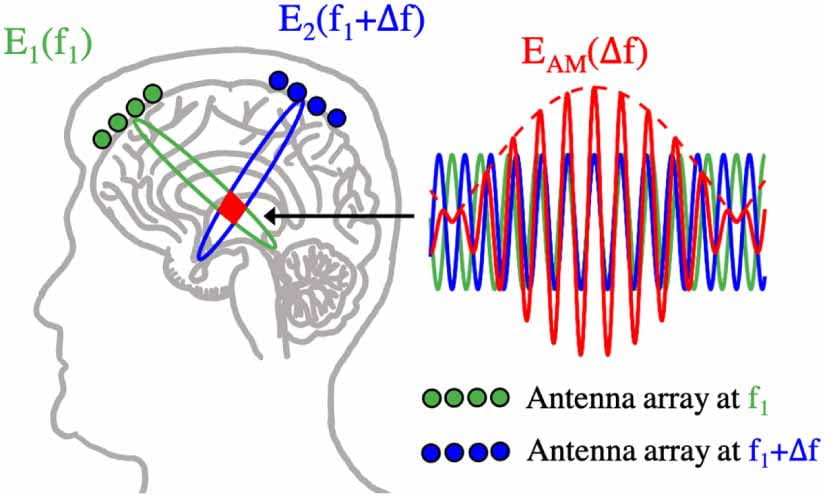Novel non-invasive neuro-stimulation treatments for neuropsychiatric disorders
Our team is exploring a novel minimally invasive deep brain stimulation (DBS) technique using temporally interfering gigahertz electromagnetic waves. The temporal interference stimulation (TIS) technique for focal noninvasive DBS was recently reported. However, subsequent computational modeling studies on the human brain have shown that while TIS achieves a higher focality of electric fields than state-of-the-art methods, further work is needed to improve the stimulation strength. In our work, we investigated the idea of EMvelop stimulation, a minimally invasive DBS setup using temporally interfering gigahertz (GHz) electromagnetic (EM) waves. At GHz frequencies, we can create antenna arrays at the scale of a few centimeters or less that can be endocranially implanted to enable longitudinal stimulation and circumvent signal attenuation due to the scalp and skull. Furthermore, owing to the small wavelength of GHz EM waves, we can optimize both amplitudes and phases of the EM waves to achieve high intensity and focal stimulation at targeted regions within the safety limit for exposure to EM waves. We develop a simulation framework investigating the propagation of GHz EM waves generated by line current antenna elements and the corresponding heat generated in the brain tissue. We proposed two optimization flows to identify antenna current amplitudes and phases for either maximal intensity or maximal focality transmission of the interfering electric fields with EM waves safety constraint. A representative result of our study is that with two endocranially implanted arrays of size 4.2 cm × 4.7 cm each, we can achieve an intensity of 12 V/m with a focality of 3.6 cm at a target deep in the brain tissue. Our proof-of-principle study shows that EMvelope stimulation merits further investigation. It can be a minimally invasive way of stimulating deep brain targets and offers benefits not shared by prior electrical or magnetic stimulation methodologies.
Biophysical simulations for EMvelop stimulation:
Our previous work calculated the spatial distributions of temporally interfering electric fields induced by antenna arrays inside the human brain tissue [1]. This part of the project focuses on understanding the interaction of EM waves at the neuronal level. This will also help us determine the stimulation intensity needed to excite the neurons, informing our animal experiments.
The electrophysiological properties of neurons can be modeled as a network of resistors and capacitors using the well-known cable theory [3]. The cable theory calculates the voltage and currents moving across the neuronal fiber due to of external stimulation. Since neurons are active structures, we have also modeled the voltage-gated ion-channels inside the neuronal membrane using the Hodgkin-Huxley model of ion-channel dynamics [3].
As we are interested in general principles governing the interaction of EM waves with neurons, we used a single myelinated axon fiber with nodes of Ranvier in it for signal exchange. An external voltage is applied to the axon fiber, and the resultant change in the potential across the axon fiber is calculated. The kinetics of voltage-gated sodium and potassium ion-channels are taken from the vestibular ganglion neurons. Cable and Hodgkin-Huxley equations implemented in COMSOL calculate the voltage and currents moving across the fiber in the time-domain.
The results of this simulation study are shown in Fig. 1.
The interaction of EM waves with biological tissues using efficient on-body antennas has been extensively studied for applications like microwave-induced hyperthermia [4-6], microwave imaging for brain injury [7,8], breast cancer detection [9], monitoring of vital signs [10], wireless communication and power transfer to implanted devices [11-13], and in-body device localization and communication [14], to name a few. However, the nonthermal therapeutic effects of EM waves have not been fully understood and mapped yet [15, 16]. A comprehensive review of the biological effects of EM waves can be found in [17, 18].
However, the nonthermal therapeutic effects of EM waves are not understood yet [19]. Due to the unique benefits of using EM waves over current stimulation technologies [1], this investigation will help us design more compact and efficient devices and stimulation protocols needed for the treatment of various neurological disorders.
Animal experiments for EMvelop stimulation:
Our biophysics work will help us determine the right stimulation intensity and parameters for our experiments on the pig model. For pig model experiments, we plan to place two antenna arrays on the pig brain. One of the antennas will operate at 1.5 GHz, and the second one will operate at 1.5 GHz + 100 Hz. We plan on targeting the motor control section of the pig brain. Due to the antennas’ optimal amplitude and phase control parameters, both signals will add constructively at our targeted motor control section of the pig brain.
If able to observe the neuronal firing as predicted by our theoretical simulations, our EMvelop stimulation approach will open a new chapter in neuromodulation technologies by offering benefits not shared by prior methodologies of electrical stimulation. It will expand the therapeutic options available to more patients with neurological and psychiatric disorders.
References:
[1] Ahsan, F., Chi, T., Cho, R., Sheth, S. A., Goodman, W., & Aazhang, B. (2022). EMvelop stimulation: minimally invasive deep brain stimulation using temporally interfering electromagnetic waves. Journal of Neural Engineering, 19(4), 046005.
[2] Thomson, W. (1856). Iii. on the theory of the electric telegraph. Proceedings of the Royal Society of London, (7), 382-399.
[3] Hodgkin, A. L., & Huxley, A. F. (1952). Currents carried by sodium and potassium ions through the membrane of the giant axon of Loligo. The Journal of physiology, 116(4), 449.
[4] Loane J and Lee S-W 1989 Gain optimization of a near-field focusing array for hyperthermia applications IEEE Trans. Microw. Theory Tech. 37 1629–35
[5] Tofigh F, Nourinia J, Azarmanesh M and Khazaei K M 2014 Near-field focused array microstrip planar antenna for medical applications IEEE Antennas Wirel. Propag. Lett. 13 951–4
[6] Loane J and Lee S-W 1989 Gain optimization of a near-field focusing array for hyperthermia applications IEEE Trans. Microw. Theory Tech. 37 1629–35
[7] Mobashsher A T, Abbosh A M and Wang Y 2014 Microwave system to detect traumatic brain injuries using compact unidirectional antenna and wideband transceiver with verification on realistic head phantom IEEE Trans. Microw. Theory Tech. 62 1826–36
[8] Mobashsher A T, Mahmoud A and Abbosh A M 2016 Portable wideband microwave imaging system for intracranial hemorrhage detection using improved back-projection algorithm with model of effective head permittivity Sci. Rep. 6 20459
[9] Nikolova N K 2011 Microwave imaging for breast cancer IEEE Microw. Mag. 12 78–94
[10] Adib F, Mao H, Kabelac Z, Katabi D and Miller R C 2015 Smart homes that monitor breathing and heart rate CHI ’15 837–46
[11] Ho J S, Yeh A J, Neofytou E, Kim S, Tanabe Y, Patlolla B, Beygui R E and Poon A S Y 2014 Wireless power transfer to deep-tissue microimplants Proc. Natl Acad. Sci. 111 7974–9
[12] Ma A and Poon A S 2015 Midfield wireless power transfer for bioelectronics IEEE Circuits Syst. Mag. 15 54–60
[13] Agrawal D R et al 2017 Conformal phased surfaces for wireless powering of bioelectronic microdevices Nat, Biomed. Eng. 1 0043
[14] Vasisht D, Zhang G, Abari O, Lu H-M, Flanz J and Katabi D 2018 In-body backscatter communication and localization SIGCOMM ’18 132–46
[15] Apollonio F, Liberti M, Paffi A, Merla C, Marracino P, Denzi A, Marino C and d’Inzeo G 2013 Feasibility for microwaves energy to affect biological systems via nonthermal mechanisms: a systematic approach IEEE Trans. Microw. Theory Tech. 61 2031–45
[16] Juutilainen J, Höytö A, Kumlin T and Naarala J 2011 Review of possible modulation-dependent biological effects of radiofrequency fields Bioelectromagnetics 32 511–34
[17] Greenebaum B and Barnes F 2019 Biological and Medical Aspects of Electromagnetic Fields (Handbook of Biological Effects of Electromagnetic Fields) 4th edn (Boca Raton, FL: CRC Press) vol 1
[18] Greenebaum B and Barnes F 2019 Bioengineering and Biophysical Aspects of Electromagnetic Fields (Handbook of Biological Effects of Electromagnetic Fields) 4th edn
[19] Wust P, Kortüm B, Strauss U, Nadobny J, Zschaeck S, Beck M, Stein U and Ghadjar P 2020 Non-thermal effects of radiofrequency electromagnetic fields Sci. Rep. 10 13488
Behnaam Aazhang, PhD
J.S. Abercrombie Professor, Electrical and Computer Engineering Director, Rice Neuroengineering Initiative (NEI), Rice University

EMvelop stimulation methodology. Superposition of GHz electric fields from two antenna arrays, shown in green and blue, differing by a small frequency offset ∆f creates the EMvelop signal, shown in red, whose amplitude is modulated at ∆f. E1 and E2 are electric fields generated by each array and EAM is the peak-to-peak value of the dashed envelope.


Fig.1: The input voltage signal to the fiber is shown in green, and the response of neurons is shown in blue. The y-axis is in mV, and the x-axis is in ms. Left. The result of stimulation of axon fiber with stimulation signal of 100 Hz. We can see that the neurons fire an action potential with every cycle of the 100 Hz stimulation waveform. Middle. The result of exciting the axon fiber with 1 GHz waveform. We see that the continuous wave GHz stimulation fails to excite the neurons, as we hypothesized. The voltage across the neuron stays at the resting membrane potential, and action potentials do not occur. Right. The result of exciting the neurons with EMvelop signal, i.e., GHz waveform amplitude modulated with 100 Hz. The neurons fire an action potential with every cycle of the EMvelop signal. This shows that amplitude modulation of the GHz waveform is necessary to cause an action potential.

Fig. 2: Adding two GHz electric fields from two antenna arrays, shown in green and blue, differing by a small frequency offset ∆f creates the EMvelop signal, shown in red. This EMvelop signal will be used to stimulate the motor areas of the pig brain.






